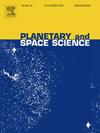Comparison of volatiles evolving from selected highland and mare lunar regolith simulants during vacuum sintering
IF 1.7
4区 物理与天体物理
Q3 ASTRONOMY & ASTROPHYSICS
引用次数: 0
Abstract
Volatiles evolving from JSC-1A, NU-LHT-4M and CSM-LHT-1G lunar regolith simulants during in vacuo thermal processing were analyzed using mass spectrometry as a function of temperature. Two high-fidelity simulants, JSC-1A (mare) and NU-LHT-4M (highland), were compared to a newly developed CSM-LHT-1G highland simulant, modified to closely match lunar geochemistry. Large autogenous gas loads were observed for all investigated materials. Mineralogical knowledge was used to identify and attribute individual volatile species to reacting, transforming, or decomposing constituents (hydrates, carbonates, sulfates, sulfides, clays, etc.) of the respective regolith simulant in the self-generated gas environment. Cumulative mass losses for individual simulant components as a function of temperature were quantified using mass spectrometry in conjunction with thermogravimetric analysis. Investigation of the four components of CSM-LHT-1G – anorthosite, basalt, augite, and glass – aided the attribution of volatile species to specific compounds and their respective sources. The results showed significant decomposition of non-lunar phases present in the man-made regolith simulants below the typical glass crystallization temperatures, which paves the way to devising methods for enhancing the fidelity of the simulants. High gas loads and corrosive gases (HF and HCl) were recognized as potential hazards, pertaining to the development of large testbed facilities.
比较真空烧结过程中从选定的高原和泥质月球碎屑模拟物中挥发出来的挥发物
利用质谱仪分析了 JSC-1A、NU-LHT-4M 和 CSM-LHT-1G 月球碎屑模拟物在真空热处理过程中挥发出来的挥发物与温度的函数关系。将两种高保真模拟物 JSC-1A(裸砂)和 NU-LHT-4M(高原)与新开发的 CSM-LHT-1G 高原模拟物进行了比较,后者经过改良以密切匹配月球地球化学。在所有调查材料中都观察到了大量的自生气体负荷。矿物学知识被用来确定和归因于自生气体环境中相应的碎屑岩模拟物的反应、转化或分解成分(水合物、碳酸盐、硫酸盐、硫化物、粘土等)的个别挥发性物种。利用质谱法和热重分析法对模拟物各成分随温度变化的累积质量损失进行了量化。对 CSM-LHT-1G 的四种成分--正长岩、玄武岩、辉绿岩和玻璃--的研究有助于将挥发性物质归因于特定的化合物及其各自的来源。结果表明,人造雷公石模拟物中的非月相在典型的玻璃结晶温度以下发生了大量分解,这为设计提高模拟物真实性的方法铺平了道路。高气体负荷和腐蚀性气体(HF 和 HCl)被认为是潜在的危险,与大型试验台设施的开发有关。
本文章由计算机程序翻译,如有差异,请以英文原文为准。
求助全文
约1分钟内获得全文
求助全文
来源期刊

Planetary and Space Science
地学天文-天文与天体物理
CiteScore
5.40
自引率
4.20%
发文量
126
审稿时长
15 weeks
期刊介绍:
Planetary and Space Science publishes original articles as well as short communications (letters). Ground-based and space-borne instrumentation and laboratory simulation of solar system processes are included. The following fields of planetary and solar system research are covered:
• Celestial mechanics, including dynamical evolution of the solar system, gravitational captures and resonances, relativistic effects, tracking and dynamics
• Cosmochemistry and origin, including all aspects of the formation and initial physical and chemical evolution of the solar system
• Terrestrial planets and satellites, including the physics of the interiors, geology and morphology of the surfaces, tectonics, mineralogy and dating
• Outer planets and satellites, including formation and evolution, remote sensing at all wavelengths and in situ measurements
• Planetary atmospheres, including formation and evolution, circulation and meteorology, boundary layers, remote sensing and laboratory simulation
• Planetary magnetospheres and ionospheres, including origin of magnetic fields, magnetospheric plasma and radiation belts, and their interaction with the sun, the solar wind and satellites
• Small bodies, dust and rings, including asteroids, comets and zodiacal light and their interaction with the solar radiation and the solar wind
• Exobiology, including origin of life, detection of planetary ecosystems and pre-biological phenomena in the solar system and laboratory simulations
• Extrasolar systems, including the detection and/or the detectability of exoplanets and planetary systems, their formation and evolution, the physical and chemical properties of the exoplanets
• History of planetary and space research
 求助内容:
求助内容: 应助结果提醒方式:
应助结果提醒方式:


